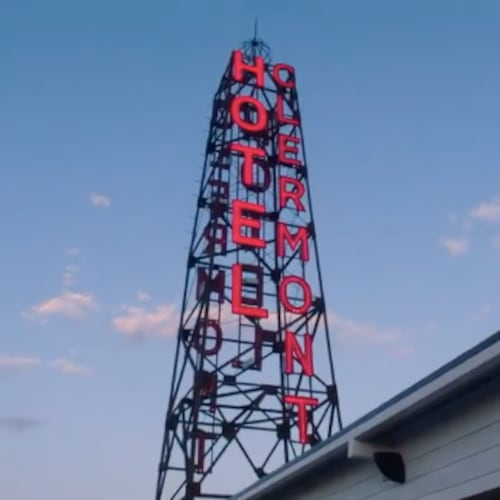Senior military historian and curator Gordon L. Jones is standing in the middle of an Atlanta History Center gallery packed with powerhouse documents, literal pages from early American history, his eyes focusing on something almost invisible.
It's a string, not much more than a thread really, tying the left temple to the frame of Abraham Lincoln's wire-rimmed spectacles, one of the items in his pockets the night he was assassinated.
"It's probably Lincoln's repair. His glasses broke and he got a piece of string and fixed it," Jones speculates. "Here's a guy who's literally installed in marble, memorialized, but he literally put his pants on one leg at a time like the rest of us, and this is a reminder of that."
"With Malice Toward None: The Abraham Lincoln Bicentennial Exhibition," opening Saturday, delivers both what Jones calls the "big-ticket stuff" (such as the Gettysburg Address) and more human-scale objects.
It's a tad late for a 200th birthday party for the nation's 16th president (who was born Feb. 12, 1809), but Jones believes this Library of Congress-organized exhibit is a perfect fit for Atlanta, its only stop in the South. The curator bases that on the fact that Lincoln's reelection in 1864 was largely dependent on the Union's victory in Atlanta, the city's fall being the Civil War's last great turning point.
"In the larger sense, this exhibit is important because the war is probably the most defining moment in American history," says Jones, curator of the history center's expansive Civil War collection and the 1,500-piece permanent exhibit "Turning Point: The American Civil War. "And the most defining person in the Civil War is Abraham Lincoln. So by extension, Lincoln sits right at the forefront of the most important people in determining the nation that we have today."
Perhaps the ultimate proof of that is the inclusion in "With Malice" of the gold-edged bible upon which Lincoln took his oath of office on March 4, 1861. Barack Obama chose to swear his oath upon the same bible on Jan. 20, 2009.
Jones points out the irony that Lincoln's oath was administered by Supreme Court Chief Justice Roger Taney, who delivered the majority opinion in Dred Scott v. Sandford (1857), broadly ruling that African-Americans could not be considered U.S. citizens.
"Boy, you think about political enemies, holy smokes," the historian says of the judge and anti-slavery politician. "And by Taney's definition, Barack Obama would not be considered a citizen, let alone a president taking oath on the Lincoln bible."
But the heart of the 185-object exhibit is the documents, many penned by the largely self-taught Lincoln in his student-like cursive handwriting.
The draft of the Gettysburg Address that is on view is a facsimile of what is believed to be the earliest copy that exists, given by Lincoln to his personal secretary John Nicolay.
The Emancipation Proclamation that's displayed is a final draft copy that was made for sale as a benefit to the Chicago Soldiers’ Home between 1863 and 1871. Jones says the final draft original no longer exists, destroyed in the famed Chicago fire of 1871.
Lincoln's first and second inaugural addresses are also displayed. The former, which is typewritten, has a revised ending in Lincoln's handwriting that includes the lines, "We are not enemies, but friends. ... Though passion may have strained, it must not break the bonds of affection." The latter was delivered from the east portico of the Capitol with its newly completed iron dome as a backdrop and symbol of the reunited union.
On a more personal note, a seed-pearl and gold necklace with matching bracelets from first lady Mary Todd Lincoln glisten even in the exhibit's low lighting (kept dim to protect the priceless documents).
"This is a great representation of her spending habits, which were out of control," Jones says. "He was most embarrassed by that."
Two other close-by objects in this deeply researched show, which includes short films of Lincoln experts drilling down on pivotal documents, will leave viewers with interesting questions.
There's a blood-stained playbill from "Our American Cousin," the play Lincoln and his wife were attending at Ford Theatre on April 14, 1865, the night he was assassinated by actor and Confederate sympathizer John Wilkes Booth.
Major Henry Rathbone, who was attending the play with the Lincolns, was stabbed by Booth when the officer attempted to stop the assassin from jumping out of the presidential box. It's not known if the blood splatter on the playbill is Rathbone's or Lincoln's.
The other mystery on exhibit is a Confederate $5 bill, the only money the president was carrying in his wallet that fateful night. Why Lincoln had that particular currency in his wallet is unknown.
"It's kind of symbolic, a souvenir from a defeated enemy," Jones says. "But as far as Lincoln was concerned, maybe it was not an enemy."
Exhibit preview
"With Malice Toward None: The Abraham Lincoln Bicentennial Exhibition"
- Opening day celebration, 10:30-4:30 p.m. Saturday includes performance of Civil War songs and stories, the play "Bull Run-Manassas Play," reciting of Lincoln speeches, a reenactment of excerpts from the Lincoln-Douglas debate, 1860s dancing, Lincoln-era games, crafts and more.
- Through Nov. 7 at Atlanta History Center, 130 W. Paces Ferry Road, Atlanta. 10 a.m.-5:30 p.m. Mondays-Saturdays, noon-5:30 p.m. Sundays. Included in AHC general admission: $16.50; $13 students 18 and up and seniors 65-up; $11 ages 4-12; free under 4. Information: 404-814-4000, www.atlantahistorycenter.com/lincoln
About the Author
Keep Reading
The Latest
Featured


